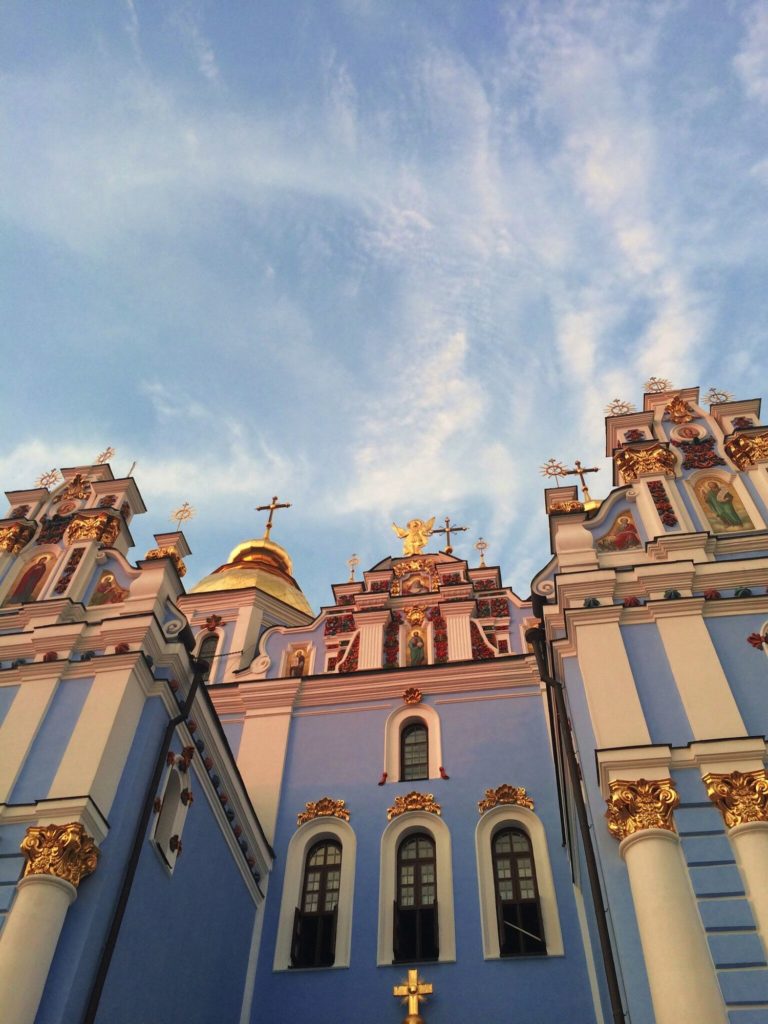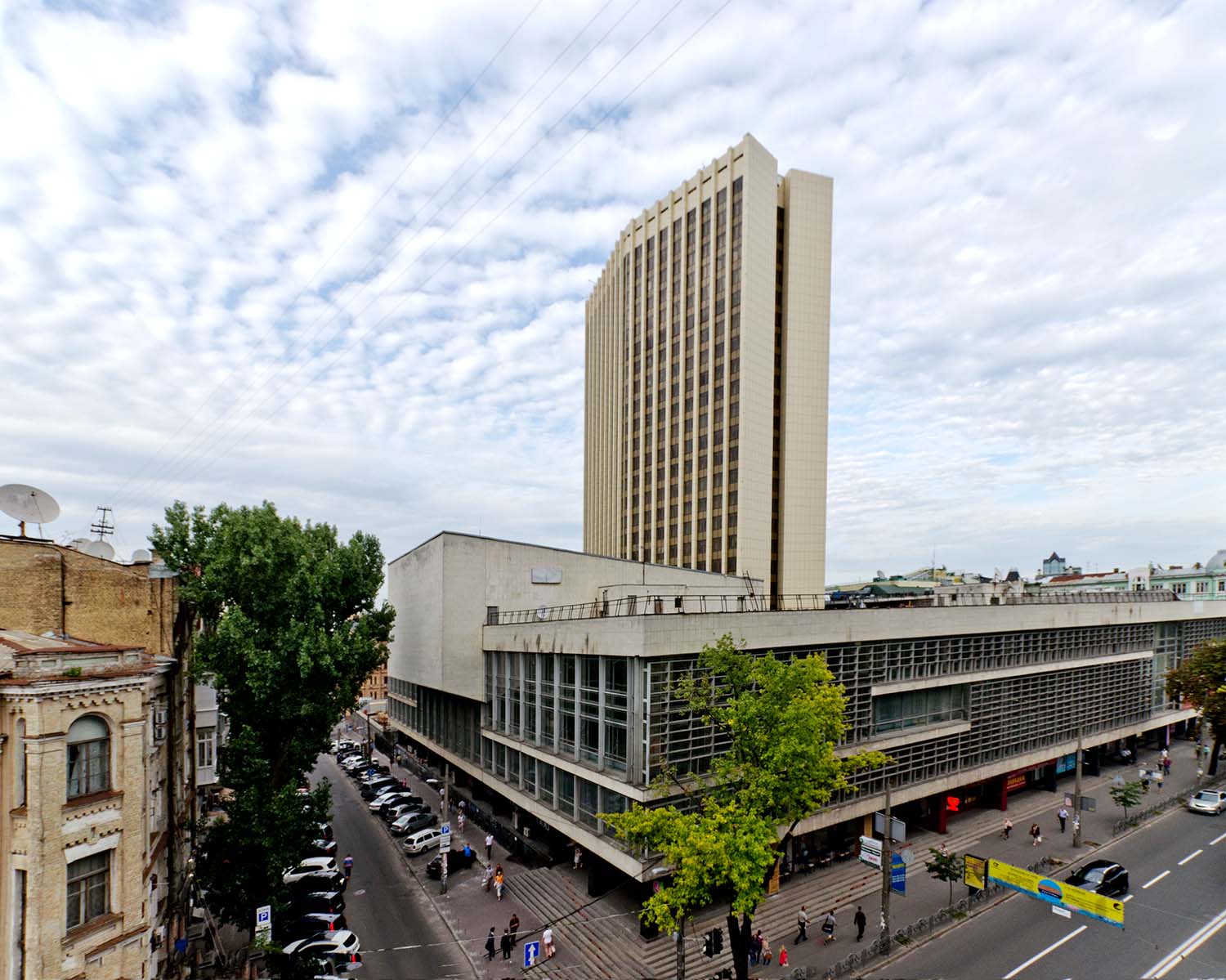
Dan Bodan spent November 8 to December 8 in residence at the Goethe Institute in Tehran. Flash Art invited him to write a travelogue during his time there. This is the third installment.
“You look emotional.”
“What?” I snap out of it.
She repeats, “I said: You look emotional.”
I’ve been staring at a star-shaped spire atop an imposing Stalinist skyscraper directly across from me on the other side of Khreshchatyk, the main Soviet-era boulevard that runs through the center of Kyiv. I’m sitting on the patio of a champagne bar on the exclusive top floor of the city’s main luxury shopping center. I’m the entertainment this afternoon for the birthday party of a shop owner/Instagram celebrity who is inexplicably a fan of my music. I’m back in Kyiv to perform as part of a local designer’s festival of young fashion talent, but he doesn’t have the budget to pay me and so has shopped me out to his rich friends as a way of subsidizing my trip. I’m getting paid a thousand euro (cash) for today’s gig and another thousand (cash) next week when I’ll perform during Mercedes-Benz Fashion Week in an enormous palace near the river. I lost my job doing content management for a stock photography start-up last month when I was replaced by an algorithm I’d been training for the past eighteen months. The laws haven’t caught up with the so-called “gig economy” and I’m ineligible for unemployment, so this money is a welcome lifeline. My audience this afternoon will be mostly children aged three to six, blissfully shuffling along to my songs about facials and Ayn Rand, while an Amazonian woman wearing stilettos and a sleek black sleeveless dress with platinum-blond Ellen Degeneres hair, freshly inked with pitch-black tattoos covering the entirety of both her arms and neck, as if she’d walked directly out of a William Gibson novel, stares angrily at everything and everyone. Champagne flows while the adult guests pose for a nightlife photographer and I help myself to caviar and smoked fish topped with gold flakes while that communist star stands there stoically in the background, quietly judging us all.
It’s not a completely passive ideological relic though; it’s been repainted from its soviet red to the colors of wheat and sky, the colors of the Ukrainian flag.
Ukraine has become something of an obsession for me since I was first brought here a year ago for the same festival. I was initially invited in 2014 as well, but before I was scheduled to arrive I received word that the situation with Russia had escalated to a point where my safety could no longer be assured.
“Oh, how interesting!” I thought to myself at the time; I’d had shows canceled in the past for a lot of different reasons (money, technical problems, personal vendettas), but war was a new one.
When I was invited again two years later, I hadn’t really been following the situation, knew nothing of the background of the conflict, and was unaware that I’d be playing in festivities related to the twenty-fifth anniversary of Ukraine’s independence from the Soviet Union. So I wasn’t prepared for the three days of relentless bravado I encountered when I arrived: celebrations of war, of fashion, of flags, of marigolds, of tanks, of dumplings, of history, of identity, of language, of bodies, of revolution, of religion, of music, and, most unexpectedly, of romance. Everything was articulated with such euphoria and vibrancy — with an aesthetic precision so refined it was as if every time I turned my head I was editing a piece of epic cinema in real time. Three days so brilliant and ridiculous and frightening and fragile that I was kick-started into what has now become a seventeen-month-long escape from my adopted home of Germany to reclaim something I forgot I was searching for when I planted myself there twelve years ago. Something I’d ultimately find on a hillside in Athens six months later.
But Kyiv wasn’t a real place, was it? Surely my memory was coloring in blind spots with images from films I studied in university or histories I’d read about online to fulfill some deeply rooted desire to experience something supreme. Even the boy I met there seemed like a creation of my deep subconscious: a mirror image of myself distorted by digital filters and liquefied to exaggerate his features, tongue processed through algorithmic translation technologies, his talents tactile as thread instead of intangible vibrations in the air.
But he was real. I met him again a month later in Paris, a city so self-conscious of its own mythology that it has the uncanny ability to demystify even the most magical of ideas (ever been to Paris Fashion Week?). And if he was real, then I had to deduce that Kyiv was a real place as well. Real places are populated by real people, and real people aren’t symbols, war isn’t theater, and my appraisal of Ukraine as merely an idea was becoming inexcusable to my (likely flawed) inner sense of morality.
And so to the internet I went and spent a year trying to learn as much as I could in an attempt to make sense of the collection of signifiers I saw collide on pavement and cobblestone that weekend. I combed through innumerable news articles, think pieces, wikis, and documentaries trying to piece together a general narrative of Ukraine’s modern history. It isn’t easy, and in my case, dependent on English-language resources, it seemed virtually impossible. Go ahead, try and Google a topic in which both Russia and the West have divergent interests: it’ll make even the biggest cynic believe in fake news and alternative facts. I’d never experienced search results so flooded with such obvious trolling from both sides. Wading through this sludge of unverified news sources, conspiracy theory blogs, “expert” editorials, and official government literature left me more confused than actually watching hundreds of tanks parade down Khreshchatyk that day in August last year; because at least I knew that had actually happened. I was there. I saw it and photographed it. I felt the canons fire.
After months of immersing myself in websites that made me as uncomfortable as the times when I’d wound up in the dark corners of the uncurated internet of the mid-1990s (rotten.com, Mr. Hands, and that first time I asked Jeeves, “What was the holocaust?”), I decided to give up and hope that the few certain facts I’d been able to accrue were giving me a semi-balanced idea of what was happening. I was still a bit disturbed by my willingness to assign the city to a place of fantasy in my memory, but it’d been a year, and the ghost image of Kyiv was finally fading from my retinas.
And then I got a DM in my Instagram asking me to return.
I was hoping that coming back would set my mind straight. That I’d return to find a city that is completely normal, familiar, comprehendible, even if just in part. But on the contrary: this time there’s even more poetics swirling around the air like pollen. Thousands of EU flags have proliferated throughout the city and have mated with the Ukrainian flag into a Frankenstein of wheat, sky, and twelve stars. Everything from backpacks to dumplings have been dyed blue and yellow. Teenagers dress in hoodies with their passports printed over their hearts, and an enormous billboard covering an entire building at Maidan Square defiantly proclaims “FREEDOM IS OUR RELIGION,” the words superimposed over an image of crumbling chain. A young boy has a swastika tattooed on his bicep, while an oligarch’s daughter has brought her defanged pet raccoon to a runway presentation north of the Dnieper River. My hotel room is entirely pink, and I wake up one morning to find the bed sheets covered in blood from a wound “the boy” suffered the night before, after falling into a ditch while trying to force open a bottle of warm Prosecco with his shoe. My trip is extended twice. By the end of my seven days in Kyiv my beard is patchy, my skin is green, my eyes are red, and my heart is in knots.
The veil is lifted once though, ever so briefly, when we take a trip out to an enormous second-hand market in a working-class neighborhood in the north. Large storage facilities and tents, filled with piles of jetsam from Germany, Switzerland, and Denmark as far as the eye can see. This is familiar, painfully normal in fact. Western Europe distributes this very same garbage to Greece, Poland, Morocco, Ghana, Nigeria, or wherever. Nothing spectacular here. Same old shit. Even the glint of revolution and the radiance of those twelve stars can’t reflect light onto something so terminally gray. I purchase a promotional hat from an obscure Swiss bank. I have a matching one in Athens that I bought from a similar market.
Ultimately, the Kyiv I experienced probably doesn’t exist. I might be able to trust my memory, but I don’t trust my heart with facts. It has the capacity to flower them in lilacs and baby’s breath until they become so saturated with petals that it’s difficult to see what the point was to begin with.
Context is impossible when you’re a tourist.
At a juice bar in Tehran, months later, I’ll pour out my feelings about Kyiv to an engineering professor I’ll have met on the subway. After my spiel he’ll pat me on the back and, laughing, say, “Yes, conflict is very exciting, isn’t it?”
A week or so following that a group of boys at a large skate park on Tabiat Bridge will practice their English on me. One will eye my Ukraine hoodie with the handsome trident coat of arms.
“Which skate company is that? It looks so cool.”
“I said: You look emotional.”
My host’s assistant, who’s accompanied me to this birthday, is waving her hand in front on my face on the shopping center rooftop patio.
“Oh, ha, no. I’m just tired I guess.” And I return my gaze to that star.
It’s bullshit though. I’m completely emotional and I haven’t felt more awake in a long time. And I love it.
And as I sit there hating myself for loving it, that blue-and-yellow commie star looks on.

